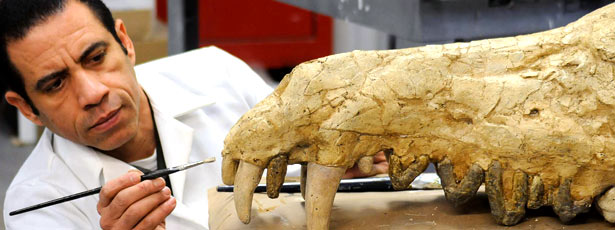Studying
Once preparation is complete, the specimen is almost ready to be used. Museums may use some specimens for display but generally only a small fraction of the specimens in a collection are used this way.
Most are intended for scientific research and are available for in-house or visiting scholars to study, or for loan to other institutions. Before this can occur, however, there are several activities that must take place.
Labeling: If a specimen becomes detached from its identifying number, it loses most of its scientific significance. The catalog number forms the link between the specimen, its associated data, and any derivatives such as molds, casts, and photographs or illustrations. It’s important that specimens and all their derivatives be labeled with the relevant catalog number, to avoid breaking this link. Read more on materials and techniques for labeling.
Molding & casting: Another way to study the specimen and obtain additional information is by producing a cast. Casts are reproductions of the object, made by pouring a liquid material, such as plaster or a resin, into a mold which has been made from the surface of the specimen. While not an inherently destructive process, molding can be damaging if not done properly. It can also be very time intensive and, for large fossils, expensive. Learn more about molding and casting.
Exhibition: Specimens intended for exhibit are often prepared differently than they would be for research purposes. The most complete specimens are often desired for both activities, which can lead to conflicting demands. Read more on the challenges preparators face in preparing fragile fossil specimens for exhibition.
Housing: Specimens need to be housed and stored properly to ensure their long-term preservation. Factors such as the specimen’s size and type of preparation will affect what solutions are adopted. Read more on housing and storage.
Conserving: Although fossil specimens may seem strong, after all they have lasted millions of years, they are often extremely fragile. Preparation can make a specimen more vulnerable to damage, or may enhance its stability. Additionally, the use of adhesives, consolidants and other chemicals also has an effect on the long-term preservation of specimens. Learn more about the factors in conserving or repairing specimens here.


